by Katharine Elizabeth Monahan Huntley

Tupperware Lady.
Donny and Marie Punk Rock!
Let’s Be Phranc.

Fig. It. Out.
“And that’s my story.”
With a dramatic flourish and certain finality, dowagers Helen O’Malley and Bow Ross finish the dish.
— Ladies’ Luncheon at Abraham & Strauss, Brooklyn, New York, circa 1957
by Katharine Elizabeth Monahan Huntley

Tupperware Lady.
Donny and Marie Punk Rock!
Let’s Be Phranc.
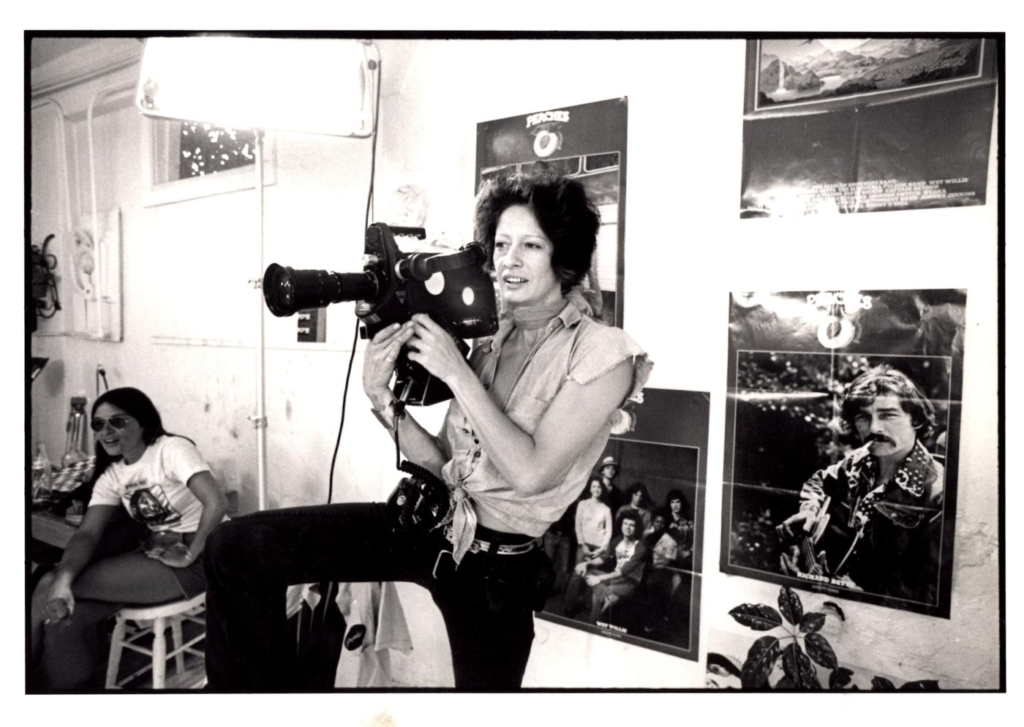
by Katharine Elizabeth Monahan Huntley
Inside the historic Vista Theater, I watch a black clad Penelope Spheeris stride down the aisle to accept Silver Lake Film Festival’s 2nd annual Spirit of Silver Lake award—an honor that “celebrates living legends who have challenged the mainstream cinema with their independent vision.” At the screening gala, held in Rudy’s Barbershop, she takes my hand, strong and sincere, as I offer my congratulations. An L.A. legend indeed.
“Do you think of yourself as a living legend?
Director Penelope Spheeris poses this question to the venerable Mr. Osbourne well into her exzzellent Ozzfest documentary, We Sold Our Souls for Rock ‘n’ Roll. It hardly needs to be asked. The religious fervor of fanatics in the stands, and the bands on the bill (Rob Zombie, Slipknot, System of a Down, et al), testify to the legacy of Ozzy Osbourne and Black Sabbath. Ozzy’s diffident answer—that he is just an ordinary bloke giving the audience a good night out is disingenuous. But it’s all part of the affable charm he uses to disarm.
The stylistic opening shot of Ozzy through the looking sunglasses is a visual metaphor for the hallucinogenic imaginings of larger than life rock and rollers taking to the stage to hype and hypnotize waves of the faithful. Amidst the carnival of sideshows and mosh pits, Ozzfest is raucous rock that does not stop.
We Sold Our Souls is not, however, a high gloss music video. It’s an endearing take on a rock and roll leader who has outlived his demons to go on to mentor young musicians, and to continue to rouse radical loyalty in any and all kinds of fans.
The real wizard of Ozzfest is Ozzy’s wife, Sharon Osbourne (producer of We Sold Our Souls). A true power chick portrayed as a pleasant British mum, Sharon Osbourne is the mettle behind the metal. Her serene veneer calms the chaos as she orchestrates the tour unseen by spectators.
For Ozzy is not invincible—along with the acclaim, Spheeris subtly depicts his occasional bouts of bewilderment. At one point he sings lyrics read off a teleprompter, another time a roadie sighs, “Ozzy’s not payin’ attention, but that’s cool.”
It is cool. The music idol simply needs to appear and bow to the cheers. And with camera and crew, Penelope Spheeris, in true “Spirit of Silver Lake” style, fiercely documents not the decline, but the dynamism of this miracle man.
Postscript 2023: I texted friend, Visual Artist Alisha Plummer, who worked on The Talk:
“Thoughts on Sharon Osbourne?”
“Love her! She was so sweet—fashionably late, but she and Ozzy would sit and eat with us at lunch. And, I vividly remember them always ordering an “L.A. Hot Dog,” and Mrs. O paying for their hot dogs from her wallet embellished with “Fuck you. Pay Me.”
by Katharine Elizabeth Monahan Huntley

“See What Happens When You . . .
Jason Schwartzman is a Magician.
. . . Do “Lottery” Stuff?”
Postscript: Shirley Jackson’s The Lottery. Read it!
by Katharine Elizabeth Monahan Huntley
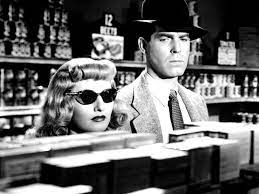
| “Kind of a crazy story with a crazy twist to it. One you didn’t quite figure out.”—Double Indemnity “A puzzle you won’t ever solve.”—Memento Christopher Nolan’s intricate trick of a movie Memento, belongs to the legacy of Billy Wilder’s film noir, Double Indemnity. Wilder’s 1944 award-winning classic, co-written with hard-boiled crime fiction author Raymond Chandler, and based upon James M. Cain’s novella, set the screen standard for all aspects noirish—amoral characters, ambivalent themes, taut plots, and an atmosphere colored by shifting shades of drifting gray. Double Indemnity’s Walter Neff and Memento’s Leonard Shelby are both in the insurance game—an industry perceived to be a necessary evil, employing as many scam artists as the clients who file false claims. Each film’s main character skirts around the edges of Los Angeles’ San Fernando Valley—where Santa Anas blow ill winds and nobody is quite whom they seem: Neff: Where did you pick up this tea drinking? You’re not English, are you? Phyllis: No. Californian. Born right here in Los Angeles. Neff: They say native Californians all come from Iowa. Teddy: Leonard, you don’t have a clue what’s going on. You don’t even know my name. Leonard: (triumphant smile) Teddy! Teddy: You read it off your fucking photo. You don’t know me, you don’t even know who you are. Neff’s “movements are easy and full of ginger.” He utters street-smart patter as he slouches against doorjambs, coolly waiting for beguiling blondes dolled up in slit summer dresses and cheap anklets to flounce down a staircase with the right proposition. In Phyllis Dietrichson’s case, it’s the disposal of her husband and collection of cold hard cash: Phyllis: Could I get an accident policy for him—without bothering him at all? Neff: . . . You want him to have the policy without him knowing it. And that means without the insurance company knowing that he doesn’t know. That’s the set-up, isn’t it? . . . And then, some dark wet night . . . You want to knock him off, don’t you, baby? Crocodile tears slither out from Phyllis’s come-hither eyes. The look is enough to hook Neff—this gun’s for hire: Neff: . . . It all tied up with something I had been thinking about for years, since long before I ever ran into Phyllis Dietrichson. Because, in this business you can’t sleep for trying to figure out the tricks they could pull on you. You’re like the guy behind the roulette wheel, watching the customers to make sure they don’t crook the house. And then one night, you get to thinking how you could crook the house yourself. . . . And suddenly the doorbell rings and the whole setup is right there in the room with you. . . . The stakes were fifty thousand dollars, but they were the life of a man, too, a man who’d never done me any dirt. Except he was married to a woman he didn’t care anything about, and I did . . . Memento’s Leonard also has a fatal obsession. Retaliation for his wife’s rape and murder: Teddy: You really wanna find this guy? Leonard: He took away the woman I love, and he took away my memory. He destroyed everything; my life and my ability to live. Teddy: You’re living. Leonard: Just for revenge. The pursuit for vengeance is problematic for Leonard, as he suffered a head injury during the incident and has no short-term memory: Leonard: I know who I am and all about myself, but . . . I can’t make any new memories. Everything fades. If we talk too long, I’ll forget how we started. I don’t know if we’ve ever met before, and the next time I see you I won’t remember this conversation. Leonard is damaged and damned—a man with no context: Leonard: I have to believe in the world outside my own mind. I have to believe my actions still have meaning, even if I can’t remember them. I have to believe that when my eyes are closed the world’s still out there. Walter Neff and Leonard Shelby do their dirty deeds, but in true cinema noir cynical fashion, they fail to attain any measure of gratification: Neff: I didn’t get the money and I didn’t get the woman. Pretty, isn’t it? Teddy: . . . We found him and you killed him. . . . I’ve never seen you so happy—I was convinced you’d remember. But it didn’t stick, like nothing ever sticks. Like this won’t stick. Dialogue that interlocks like a zipper’s metal tabs creates complicity between the audience and anti-heroes of Double Indemnity and Memento. Yes, they’re killers, but killers wry and witty: Neff: Where would the living room be? Maid: In there, but they keep the liquor locked up. Neff: That’s okay. I always carry my own keys. Leonard: So how many rooms am I checked into in this dump? Burt: Just two. So far. Leonard: Well, at least you’re being honest about cheating me. Burt: Yeah, well you’re not gonna remember, anyway. Leonard: You don’t have to be that honest, Burt. Walter and his paramour, partner-in-crime Phyllis, mortally wound each other, a strategic decision in obtaining script approval from the Hays Office because the “. . . Production Code still demanded that criminals pay onscreen for their transgressions.” Before his death, Neff confesses all to Barton Keyes—the man who plays the part of Neff’s conscience: Neff: I wanted to straighten out that Dietrichson story for you. . . . And now I suppose I get the big speech, the one with all the two-dollar words in it. Let’s have it, Keyes. Keyes: You’re all washed up, Walter. Neff: Thanks, Keyes. That was short anyway. In this new millennium, (particularly in independent film), Nolan has no such morality constraints. He is not limited to black and white—literally, in the aesthetic of the film’s look, or figuratively, in the ambiguity of the story’s outcome. Cool blue hues saturate Leonard’s world of loss. Users and losers are on hand to lend menace and pathos. They slink on the sidelines of salvation—no chance or care for redemption. Femme fatales look vaguely the same: opaque-eyed and contemptuous. Including Leonard’s dead (if she is indeed) wife. Tragedy thrives in the burnt embers of her mementos—the love he “can’t remember to forget”: Natalie: What’s the last thing you remember? Leonard: My wife. Natalie: Sweet. Leonard: Dying. Beyond avenging his wife’s death, Leonard becomes a killer for his own convenience. Once Teddy, Leonard’s untrustworthy and unreliable sidekick, accuses him of deliberate memory fidgeting to continue the quest for: “a dead wife to pine for and a sense of purpose in your life,” Leonard blows him away. Tossing Teddy’s car keys into the bushes, Leonard Shelby metaphorically kisses the “keys” to his conscience good-bye, and Christopher Nolan ushers in his version of neo-noir. Much to the delight, one may well imagine, of Billy Wilder’s grinning ghost. Notes Billy Wilder and Raymond Chandler, Double Indemnity (original shooting script dated September 25, 1943), reproduced in Double Indemnity/Billy Wilder; screenplay by Billy Wilder, Raymond Chandler; with an introduction by Jeffrey Meyers. (Berkeley: University of California Press, 2000), p. 26. Christopher Nolan, Memento (screenplay dated October 4, 1999), pp. 3-3A. Wilder, Double Indemnity, p. 11. Ibid., pp. 28-29. Ibid., pp. 36-37. Nolan, Memento, p. 30. Ibid., p. 9. Ibid., p.118. Wilder, Double Indemnity, p. 11. Nolan, Memento, p.115. Wilder, Double Indemnity, p. 14. Nolan, Memento, p. 25. Kevin Lally, Wilder Times: The Life of Billy Wilder (New York: Henry Holt, 1996), p. 134. Wilder, Double Indemnity, p. 116. Nolan, Memento, p. 57. Ibid., p. 87. Ibid., p.116. |
by Katharine Elizabeth Monahan Huntley

| ₚₕₒₜₒ by ⱼₐₙₑ ₘ. Gₐᵣᵣᵢₛₒₙ |
LEONARD
How can you read that again? . . . You’ve read it a hundred times.
LEONARD’S WIFE
I enjoy it.
LEONARD
Yeah, but the pleasure of a book is in wanting to know what happens next.
Ironic words coming from writer/director Christopher Nolan. The thrill of the unusual, yet captivating, storytelling style of Memento, based upon brother Jonathan Nolan’s short story, is in wanting to know what happens first.
The story backtracks, end to beginning. It sidesteps, omits, and misleads as well. Leonard, an insurance claims investigator, is determined to avenge his wife’s rape and murder. Problematic, as he suffered a head injury during the incident and has no short-term memory.
LEONARD
I know who I am and all about myself, but . . . I can’t make any new memories. Everything fades. If we talk for too long, I’ll forget how we started. I don’t know if we’ve ever met before, and the next time I see you I won’t remember this conversation.
Cool blue hues color Leonard’s world of loss. He navigates his “romantic quest which [he] will not end” with tattoos, handwritten notes, charts, and Polaroids. Users and losers are on hand to lend menace, pathos, and sardonic humor. Femme fatales look vaguely the same: opaque-eyed and contemptuous. Including Leonard’s dead (if she is indeed) wife.
Tragedy thrives in the burnt embers of her mementos—the love that he “can’t remember to forget.”
NATALIE
What’s the last thing you remember?
LEONARD
My wife.
NATALIE
Sweet.
LEONARD
Dying.
Leonard is damaged and damned—a man with no context.
LEONARD
I have to believe in the world outside my own mind. I have to believe my actions still have meaning, even if I can’t remember them. I have to believe that when my eyes are closed, the world’s still out there.
Certain to become, at the very least, a cult classic, Memento is reminiscent of other noirish films like Blade Runner, Blow Up, and Double Indemnity. The line between reel and real life blurs after I exit the movie theater, right into Memento’s world. You see, the Limbo Land in which Leonard chases ghosts, is the neighborhood I live in.
All quotations from the Memento shooting script.

“Natalie’s House”
This dilapidated house located on Magnolia Blvd. in Burbank is inhabited by a cranky old man who does not take well to nosy parker neighbors peering in his windows. Look closely in the film and you can see his pastel portrait hanging on the living room wall. (By the way, that’s Paul Thomas Anderson’s Magnolia Blvd., as well.) The neighborhood is also home to Memento film crew member Corey Geryak, a dynamo (Lunge Queen JoDee), and their towhead sons.
“Ferdy’s”
(pictured at top of page)
Local watering hole where Natalie tends bar. In reality, it’s Burbank’s The Blue Room, where Lew pours lethal Lemon Drop cocktails—and Judi serves them up with a side of bitter. The Blue Room is (in)famous for its annual New Year’s Eve shindig.
by Katharine Elizabeth Monahan Huntley
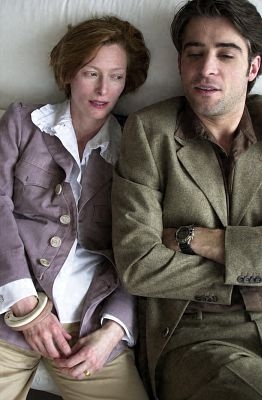
| How do parents react to the notion their child may be homosexual? In Jamie Babbit’s But I’m a Cheerleader, a film that aspires to be high camp, a young cheerleader suspected of Sapphic yearnings is sent straight to “straight camp” for deprogramming. With the exception of the fab faux 50s set design and cameo-worthy stars like Bud Cort and Mink Stole, it’s utterly cheerless. Scott McGehee and David Siegel’s The Deep End takes a more somber view of Sex Ed. Once main character Margaret Hall discerns her son Beau’s sexual orientation, immediate suppression is the task at hand. Margaret runs errands and runs interference in Beau’s extracurricular activities. When she discovers his sleazy lover’s impaled body on the family dock, it’s anchors away as the offending corpse is disposed of right into Lake Tahoe’s chilly depths. One more to-do item crossed off her list. What Margaret deliberately avoids is alerting authorities, or asking Beau about the dead man. This efficiency model does not use her common sense—instead she leaves herself vulnerable to the melodrama of blackmail and potentially, jail. That a mother’s lot is filled with many and mundane details—enough to cause one to go off the deep end—is the only way to fathom the implausible premise. Tilda Swinton, with her crisp competence and precise manner does manage to nicely button up the film. Goran Visnjic, the brooding blackmailer she swiftly puts to shame, is quite good (not to mention good-looking), as well. Film bleu is the new film noir as The Deep End is awash in turquoise water symbols. Apologies for the pun, but it’s difficult to restrain oneself when virtually every single frame from Sparkletts to Swan Lake contains a H20 allusion. Stylish, yet distracting. Perhaps the imagery is intended to divert the audience from contemplating the irrationality of a mother who, under the guise of protector, cannot confront her child on critical issues of innocence or guilt. Ignorance is not always bliss. It is often the agony of intolerance. |
by Katharine Elizabeth Monahan Huntley

As the frozen supertoy boy stares fixedly at the Blue Fairy reciting Pinocchio’s mantra, I too begin a silent chant: Let this be the final scene, let this be the final scene, let this be the final scene . . .
It’s not, of course. For director Steven Spielberg to allow a mainstream film end in a moment of melancholia is far too great a wish.
A.I.: Artificial Intelligence relates a futuristic story of a robotic boy’s love for his adoptive mother. Advanced technology enables “mecha” David to operate fully loaded—with logic and emotion. He is sent to live with one of the manufacturers, Henry Swinton and his grief stricken wife, Monica, ostensibly to replace their comatose son, Martin.
Once Martin—insecure and inhumane—miraculously regains consciousness and comes home, David has exceeded his usefulness and is abandoned to the grim fairy tale forest.
Imprinted with an obsessive Oedipus complex, the robot child is certain if he were only transformed into a real boy, his mother would welcome him back. David and his irritating walking/talking teddy bear set off on this quest, by way of Shirley Jacksonesque “flesh fairs” and mad scientists.
Visually, A.I. a cinematic astonishment: Manhattan drowning, Gigolo Joe jubilantly tap dancing, wizardly Rouge City beckoning.
As a story, the problem lies in its key characters. They are not complex in an interesting way; rather, their actions confound. Examples: The seemingly intelligent Swintons do not recognize their only offspring is an obvious bad seed; and doesn’t anybody realize David’s highly respected creator, Professor Hobby, cloned his own deceased son?
Stanley Kubrick’s ghost floats about A.I., haunting the unrealized potential for a sophisticated psychodrama. The weird happy ending (extraterrestrials are involved), however, is unmistakably Spielberg—more artificial sweetener than artificial intelligence.
An inevitable waltz into schmaltz.
by Katharine Elizabeth Monahan Huntley
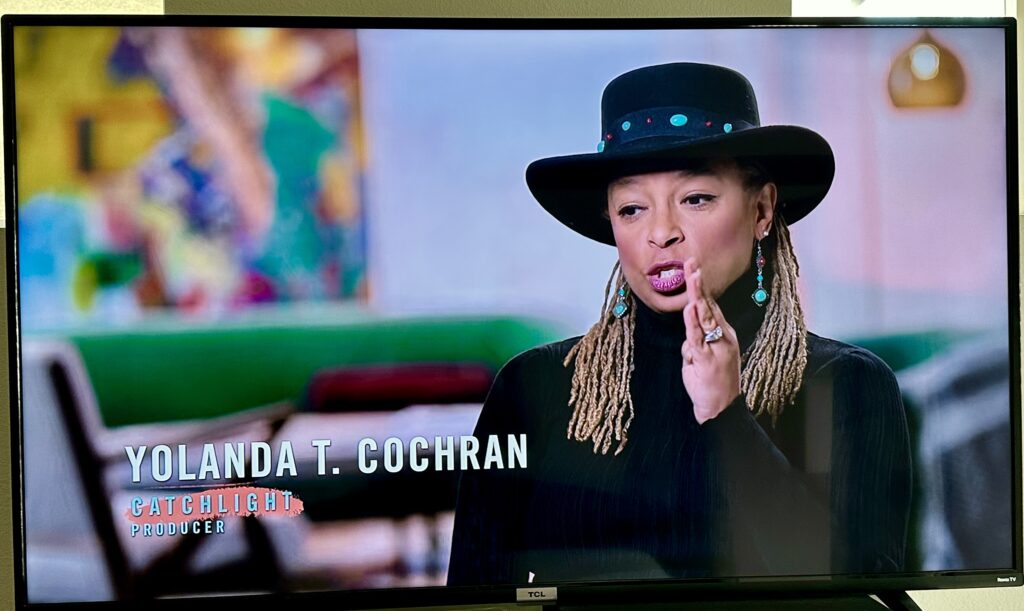
Yolanda Thibodeaux Cochran’s effervescent Instagram announcement immediately caught my attention:
June 21
@yolandatcochran
My peeps! So excited to finally be able to share that Project Greenlight is back, and I had the great privilege to produce the resulting feature film GRAY MATTER alongside @jeanettevolturno!
@IssaRae, @KumailN, and @GPDmadeit give the next generation of filmmakers the chance of a lifetime, but only one gets to direct her first feature film. And this season makes it abundantly clear (contrary to some narratives), that the pool of capable female directors is OVERFLOWING! Working with the truly talented @mekowinbush was such a pleasure and career highlight. Can’t wait to watch her star rise!
@katy.huntley
Yo! I know I wrote a review once, but I can’t seem to find it. I do luv the Project Greenlight series! Congrats!
@yolandatcochran
Looking forward to your thoughts this season. Maybe you could write new review?!
Friday 2:57 PM
Katy: Well, hello star! Binge ing PG rn!
Yolanda: . . . I want to know ALL your thoughts. All of them.
Fast break Quick take:
Viewing the behind-the scenes of movie-making is where the delicious drama lies. Selecting Meko Winthrop initially appeared to be a solid choice. Her calm, shy, demeanor belied her vulnerable, funny, and fiercely stubborn nature that emerged early on.
The rules of the Project Greenlight world were elucidated; stakes were stated from the get-go by all invested parties, with clear articulation and much repetition. The script required rewriting before the eighteen-day shoot, which recalcitrant Meko resisted.
Attempting to be supportive of Meko’s vision, and understanding of the vulnerable first-time feature film director, the powers that be were not direct, until Episode 3 with eight minutes left:
Yolanda: Time has come for a “Come to Jesus” meeting.
I had to immediately repair to White Heat Yoga to prepare for the “what for” in Ep four.
All ten episodes wildly entertain, but the big delight is watching a true-blue friend televised in her professional element—slaying the game without ever veering from her vibrant vivacious self.
Way to go, Yo!
by Katharine Elizabeth Monahan Huntley
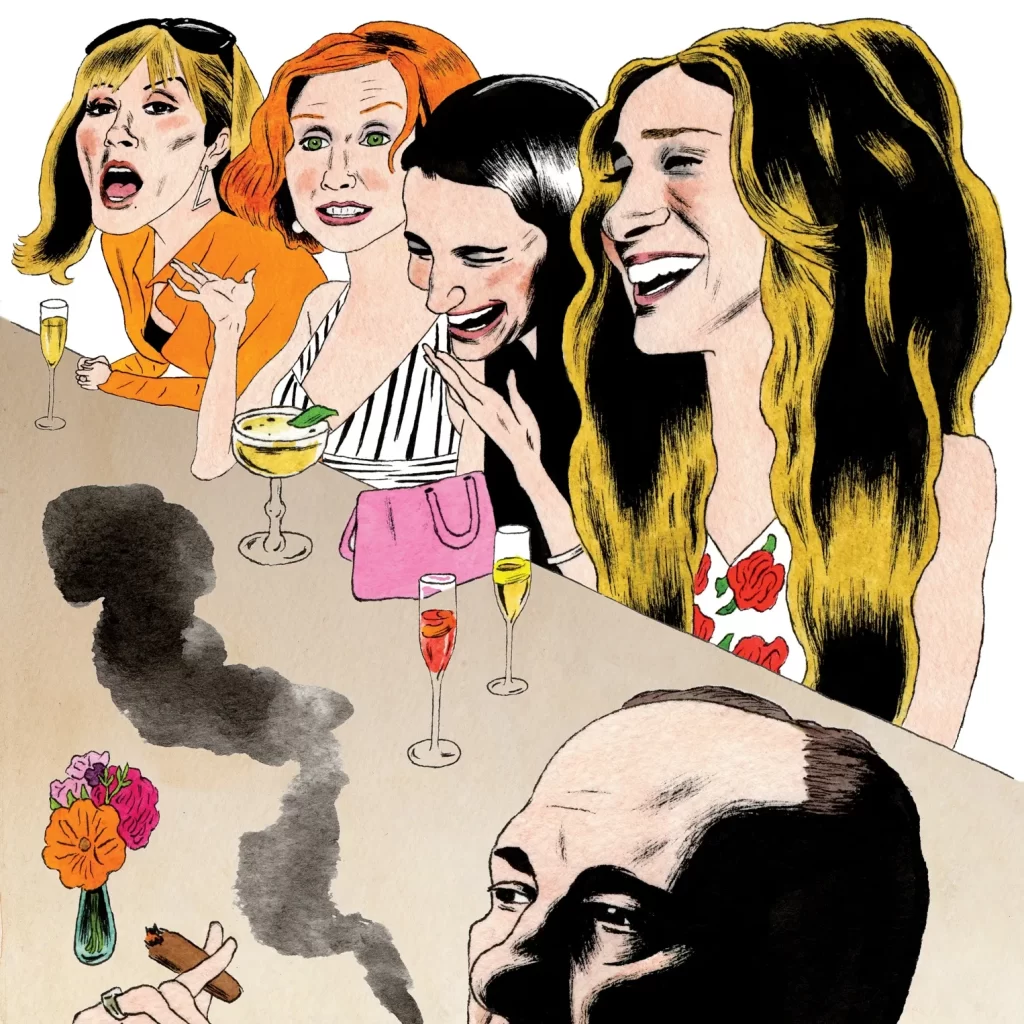
Illustration by Andy Friedman
Charlotte: I’ve been dating since I was fifteen. I’m exhausted. Where is he?
Miranda: Who? The White Knight?
Samantha: That only happens in fairy tales. (1)
“Modern women need cheat sheets to remind us romance isn’t dead.” (2)
Jane Austen’s heroines do not only exist in early nineteenth century literature. “Cher” is an up-to-date Emma in Amy Heckerling’s Clueless. The titular character in Bridget Jones’s Diary is reminiscent of Pride and Prejudice’s Elizabeth Bennett—only now she’s a hip London “singleton” navigating among the “smug marrieds.” Written in the spirit of Ms. Austen, four New York singletons offer their own Girls’ Guide to Hunting and Fishing with cosmopolitan wit in HBO’s Sex and the City.
Faithful to the ideal of romantic love is sweet Charlotte, originally an art dealer and now a divorcee. Miranda, a corporate lawyer, represents sensibility bordering on skepticism. Damn the torpedoes sexual temptation is embodied in publicist Samantha. Main character Carrie Bradshaw considers and synthesizes these and her own disparate perspectives on the love and war front. Carrie shares Elizabeth Bennett’s “quickness of observation.” (3)
She poses questions, carries out research, and reports on the city that never sleeps’ escapades and exploits. (Note: The first episode of the series begins with Carrie interviewing an English journalist named Elizabeth, and ends with her bumping into her own Mr. Darcy, enigmatically christened “Mr. Big.”)
These single successful career women are engaged in love/lust relationships confined to twenty-two square miles of Manhattan. Like the village in which Jane Austen locates her select society, Sex and the City, based on author Candace Bushnell’s column, is only a “. . . small subset of high-profile New Yorkers: fashion people, media honchos, money people, famous-for-fifteen-minute-artists.” (4)
Sex and the City’s universe is specific—yet its themes are universal. What intrigues Sex’s writers, and ultimately its audience, are the same kinds of thematic conflicts Austen writes about:
“[Jane Austen] is interested in dramatizing sex in everyday social life—in the drawing room rather than the bedroom. The courtship plots she creates allow her to explore the relations between sex and moral judgment, sex and friendship, sex and knowledge—that is, between sex and character. . . . The very publicity of sex in Austen’s novels—the constant awareness, the relentless dramatization—is what makes her examination of social life so powerful.” (5)
The writers for Sex and the City are not restricted to the drawing room. What happens behind closed doors is on screen in full view, yet the salacious is only a diversionary hook. Discourse on mores and manners, particularly givens associated with gender roles, is what constitutes the show’s substance, much like in Austen’s world:
“The lives of Jane Austen heroines, who spend much of their time at balls, dinners and on extended visits, should not . . . be considered trivial. Essentially they are engaged in receiving an education in manners, the subtleties of which can be fully explored only in the context of the formal social occasion, and are thus being prepared for their role as arbiters of manners and preservers of morals. By undergoing this process, and by eradicating the deficiencies in manners . . . the heroines eventually become as useful to society as any politician, soldier or clergyman.” (6)
Sex and the City is a comedy, and as such the leading ladies have a vast comic repertoire to draw from (broad humor for Carrie’s “fashion roadkill” (7) pratfall; black humor for Miranda’s mother’s death) (8). Comedy is the essential accessory for trifling issues: Manolo Blahniks or Jimmy Choos shoes? as well as the severe “running with scissors” (9) situations. The 5th’s season finale leaves the New Yorkers still girlfriends, still single, and still cynical—yet romantic enough to fall sway to the strains of a song playing at an acquaintance’s wedding reception: “Is that all there is? Is that all there is? If that’s all there is my friends, then let’s keep dancing . . .” (10)
As ever, everything that’s classic is fabulous again. Whether we are perusing Jane Austen’s literature or tuned into Sex and the City, we can all relate to the “delightful commentary upon the little foibles of human nature” (11)—a “perpetual human comedy, in which we all have to play our parts.” (12)
Postscript:
Twenty one years after first publishing the Jane Austen Heroines’ article, And Just Like That showcases the character, Amelia Carsey, as a voiceover artist performing a dramatic reading of Pride and Prejudice.”
Footnotes
1 “Where There’s Smoke.” Writ. Michael Patrick King. Sex and the City. Created by Darren Star. Dir. King. HBO. Season 3: Episode 31. June 4, 2000.
2 “Are We Sluts?” Writ. Cindy Chupack. Sex and the City. Created by Star. Dir. Nicole Holofcener. HBO. Season 3: Episode 36. July 16, 2000.
3 Swisher, Clarice. Ed. Readings on Jane Austen. San Diego: Greenhaven Press, 1997.
4 Franklin, Nancy. “Sex and the Single Girl.” The New Yorker, July 1998: 74-77.
5 Fergus, Jan. “Sex and Social Life in Jane Austen Novels,” in Jane Austen in a Social Context. Ed. David Monaghan. Macmillian Ltd., 1981.
6 Monaghan, David. “Jane Austen and the Position of Women,” in Jane Austen in a Social Context. Ed. David Monaghan. Macmillian Ltd., 1981.
7 “The Real Me.” Writ. King. Sex and the City. Created by Star. Dir. King. HBO. Season 4: Episode 50. June 3, 2001.
8 “My Motherboard, My Self.” Writ. Julie Rottenberg and Elisa Zuritsky. Sex and the City. Created by Star. Dir. Michael Engler. HBO. Season 4: Episode 56. July 15, 2001.
9 “Running With Scissors.” Writ. King. Sex and the City. Created by Star. Dir. Dennis Erdman. HBO. Season 3: Episode 41. August 20, 2000.
10 “I Love a Charade.” Writ. Chupak and King. Sex and the City. Created by Star. Dir. Engler. HBO. Season 5: Episode 74. September 8, 2002.
11 Moore, Catherine. “Pride and Prejudice.” Masterplots. Ed. F. N. Magill. Englewood: Salem, 1976.
12 Priestly, J.B., “Afterword,” in Four English Novels. Eds. J.B. Priestly and O.B. Davis. New York: Harcourt, 1960.
by Katharine Elizabeth Monahan Huntley

| Please, give me a second grace/ Please, give me a second face. I’ve fallen far down/the first time around/ Now I just sit on the ground in your way. Now, if it’s time to recompense, for what’s done/ Come, come sit down on the fence, in the sun. And the clouds will roll by/and we’ll never deny/ It’s really too hard . . . to fly.—Nick Drake Imperial in manner and impervious to any but his own interests, patriarch Royal Tenenbaum acts out atrociously, conferring “betrayal, failure, and disaster” upon his wife and three precocious prodigies in writer/director Wes Anderson’s melancholy New York story, The Royal Tenenbaums, co-written with Bottle Rocket and Rushmore collaborator, Owen Wilson; original music composed by Mark Mothersbaugh. Royal is the errant center of Anderson and Wilson’s distinctly drawn gallery of idiosyncratic characters. An unfaithful husband and unaware parent, he indulges in deception, favoritism, and occasional thievery with genial charm. Early on, an exasperated Etheline banishes Royal from their Archer Avenue castle: Margot: Are you getting divorced? Royal: It doesn’t look good. Margot: Is it our fault? Royal: [less than reassuring] Obviously we made sacrifices as a result of having children. But no . . . Lord, no. Royal’s subsequent interactions with his offspring are intermittent and marred by Freudian psychodramatics. A sense of entitlement (yet without the proper financial backing) maintains Royal as a guest of the Lindbergh Palace Hotel for twenty-two years until they, too, ask him to leave. And thus Royal re-enters Etheline and his adult children’s lives, certain he can cadge a measure of redemption. What he discovers is a modern day Glass family: numb, suicidal, and hostile towards his infiltration attempts: Royal: You think you can start forgiving me? Chas: Why should I? Royal: [indignant] Because you’re hurting me! A widower with two young sons, Chas has most at emotional stake in the Royal family. Unlike his father, he is protective of Ari and Uzi—but to their detriment. Petrified that death and destruction are imminent, he quells their adventurous nature: Royal: Chas has those boys cooped up like a pair of jackrabbits, Ethel. Etheline: He has his reasons. Royal: Oh, I know that. But you can’t raise boys to be scared of life. You gotta brew some recklessness into them. Etheline: I think that’s terrible advice. Royal: No you don’t. With egregious glee, Royal takes the lads on a tear, exacerbating the conflict. The ensuing argument Royal and Chas have carries on inside the hallway closet where shelves of classic board games line the walls. Fortune 500, Operation, Strategy, Risk, and Last Word exemplify the kind of ingenious storytelling subtlety that makes Anderson and his Go To crew the Head of the (Hollywood) Class. All apologies aside, Royal remains constant in his slippery solipsism, try as he might to change. It is finally Chas who veers off his intractable course of righteousness and forgives his father. Soon thereafter, Royal suffers a fatal heart attack. The epitaph on his headstone, authored by his own hand (and proofread by Etheline at his request), reads: “Died tragically rescuing his family from the wreckage of a destroyed sinking battleship.” The listing vessel none other than himself, Royal O’Reilly Tenenbaum. |